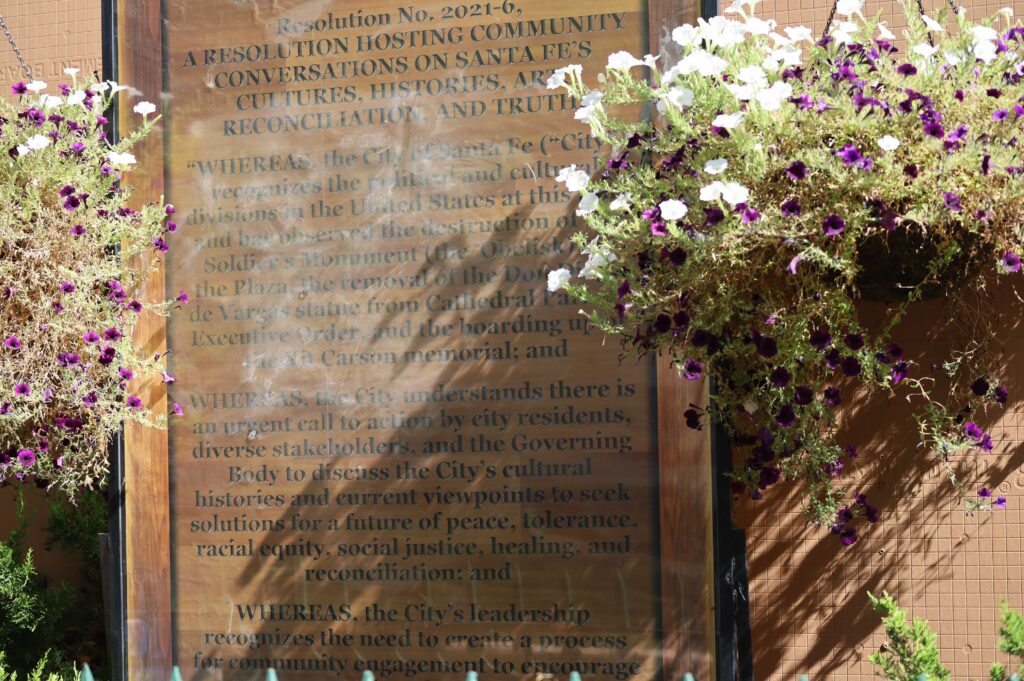City of Santa Fe officials authorized the placement of this sign which attempts to provide historical information about the box that encases the base of what remains of the former Soldier’s Monument on the Santa Fe Plaza, Santa Fe Mayor Alan Webber said in court on Thursday, Sept. 12, 2024. Residue of graffiti can still be seen on the sign’s acrylic covering. (Photo by Shaun Griswold / Source NM)
Santa Fe city government officials didn’t violate the law when they started the process of removing a controversial monument in 2020, because in a strict legal sense it is irrelevant to the plaza’s historical significance, the mayor of Santa Fe and an expert witness said in court Thursday afternoon.
The first day of the trial over the former Soldier’s Monument, which is at the center of New Mexico’s capital city, ended about 30 minutes early after both sides heard from witnesses.
The plaintiffs, the Union Protectiva de Santa Fe, rested their case after hearing testimony from defendant Alan Webber, the city’s mayor.
The defense called its last witness, a historian and archaeologist, later on Thursday afternoon.
On Friday morning starting at 9 a.m., both sides intend to make closing arguments. First Judicial District Court Judge Matthew Wilson will determine the outcome for the case with a judgment.
Mayor didn’t want rerun of 2017 Entrada protest
The Union Protectiva argued Webber’s proclamation was unlawful because the city government never did the legally required planning to come up with alternatives to remove three monuments in the city. The group argued that Santa Fe was barred from spending public funds in the way it did to remove the monuments.
Webber said at the time he issued the emergency proclamation to state that Santa Fe was facing the possibility of civil unrest, due to reports of imminent demonstrations and counter-protests at monuments.
He said he was worried about the potential for violence.
Taking inspiration from formal Pueblo boycotts of the Santa Fe Entrada pageant in the late 1970s, a new generation of activists reinvigorated the public debate around the event, which boiled over during a high-profile protest in 2017.
Webber said when he had taken office in 2018, he had been briefed on what happened, and heard about police carrying sniper rifles on rooftops and arresting demonstrators that day in 2017.
He told the court on Thursday that learning about that situation made him feel obligated as mayor to never allow something similar to happen under his watch.
After the obelisk in the Plaza was torn down, Webber and the Santa Fe City Council created the Culture, History, Art, Reconciliation, and Truth (CHART) Process. It was modeled after similar commissions in the U.S. and globally.
“It was a yearlong community engagement effort and it, in some ways, was very successful,” Webber said. “We had community conversations that otherwise would not have taken place. There were people who were very involved who became friends — who thought they were adversaries — because of this process.”
What it revealed was that the divisions over the Soldier’s Monument existed before the review and remain unresolved afterwards, Webber said.
“I think it’s not just the monument, it becomes the object upon which people can express those divisions,” he said.
Webber said the CHART Process does not meet the definition of a project or process as defined in state law governing historically significant sites because it did not obligate the city government to do anything.
He added that it specifically recommended more discussion about the Soldier’s Monument.
There is a resolution about the Soldier’s Monument currently going through the city’s legislative process and has not yet been accepted by the City Council, Webber said.
Santa Fe Plaza obelisk trial begins with testimony
Obelisk irrelevant, expert testifies
Webber also said he did not consult with the state historic preservation officer before issuing the proclamation because he and Santa Fe officials thought the public safety emergency was enough to move forward.
“I feel pretty clear that we didn’t trigger that requirement by doing this, because we didn’t adversely affect the site,” Webber said.
The defense’s other witness was Kimberly Parker, senior project manager and architectural historian for Albuquerque-based Environmental Consulting and Technology.
Judge Wilson qualified Parker as an expert in the way federal law is applied when listing a property on the National Register of Historic Places.
Places can get on the register when either a member of the public or Congress nominates it through a form created by the National Park Service, Parker said.
The Santa Fe Plaza was designated a national historic landmark by the National Park Service in 1960, Parker said.
The National Historic Preservation Act was passed in 1966, and the National Register of Historic Places didn’t exist until 1969. and the Plaza was included automatically because it was already a national historic landmark, Parker said.
In her opinion, the Soldier’s Monument is irrelevant to the Santa Fe Plaza’s listing on the register because even though the nomination form mentions the obelisk in the Plaza’s physical description, it is not included in the part of the form used to describe the Plaza’s historical significance.
On cross-examination, Parker said she is not giving an opinion about whether the Soldier’s Monument could or should be eligible to be listed, or whether it is significant on its own.
SUPPORT NEWS YOU TRUST.
GET THE MORNING HEADLINES DELIVERED TO YOUR INBOX

